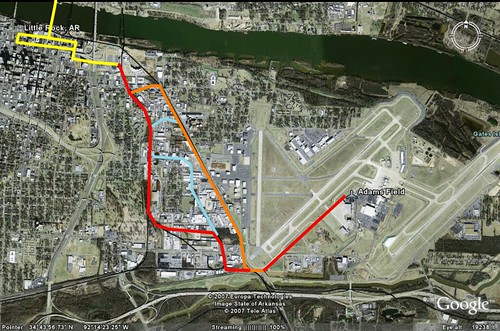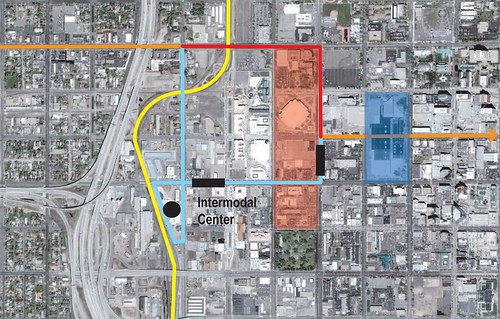There were a lot of stories this week covering the expansion, creation, or history of streetcar lines:
The Tempe Chamber of Commerce is creating a streetcar committee and there were articles in local papers discussing the idea: East Valley/Scottsday Tribune.
Portland has approved funding to keep the Eastside streetcar moving. The Oregonian is following the story.
Little Rock has a streetcar system and is thinking of expanding to the airport. THV has the article. I was struck again by how cheap Little Rock can get it done. Their last expansion was only 7 million a mile and the article makes it seem that they could keep the cost that low again. I've created a map that shows the extension area below and it seems like they would use former railroad ROW. This would make the costs of the line more like railroad costs which is much cheaper.The Portland City Council took a leap of faith Thursday, forced by a deadline to quickly commit $27 million toward building a $147 million extension of the streetcar to the east side.
The project carries some financial risk for the city, but the commissioners agreed that the streetcar could spark the kind of development boom on the east side that has accompanied the westside line through the Pearl, the west end of downtown, the River District and South Waterfront.
"We hope to knit together the east and west sides of the city in ways we would not be able to do otherwise," City Commissioner Sam Adams said.

North Little Rock Mayor Patrick Hays says that a planned extension to Heifer International's headquarters would leave only three or four miles to cover to reach the airport. Hays says extending the line to the airport would allow visitors to take the streetcar directly to downtown hotels. Central Arkansas officials are looking into the feasibility of the proposal and a consultant is helping explore the idea. Running the line to the airport would cost an estimated 20 million dollars. Federal grants would cover 80 percent of the cost.
And finally, a series of History Lessons about Sacramento's Streetcar system over at the Sacramento History Blog.
Part 1: Sacramento Streetcar Suburbs
Part 2: Central Street Railway
Part 3: PG&E and It's Predecessors
Part 4: East Sacramento and Elmhurst


